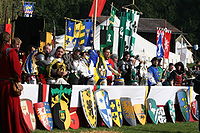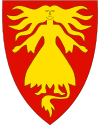Welcome to the Heraldry and Vexillology Portal!


Heraldry encompasses all of the duties of a herald, including the science and art of designing, displaying, describing and recording coats of arms and badges, as well as the formal ceremonies and laws that regulate the use and inheritance of arms. The origins of heraldry lie in the medieval need to distinguish participants in battles or jousts, whose faces were hidden by steel helmets.
Vexillology (from the Latin vexillum, a flag or banner) is the scholarly study of flags, including the creation and development of a body of knowledge about flags of all types, their forms and functions, and of scientific theories and principles based on that knowledge. Flags were originally used to assist military coordination on the battlefield, and have evolved into a general tool for signalling and identification, particularly identification of countries.
Selected article

The Shield of the Trinity or Scutum Fidei is a traditional Christian visual symbol which expresses many aspects of the doctrine of the Trinity, summarizing the first part of the Athanasian Creed in a compact diagram. In medieval England and France, this emblem was considered to be the heraldic arms of God (and of the Trinity). The precise origin of this diagram is unknown, but it was evidently influenced by 12th-century experiments in symbolizing the Trinity in abstract visual form, mainly by Petrus Alfonsi's Tetragrammaton-Trinity diagram of ca. 1109.
The Shield of the Trinity diagram is attested from as early as a ca. 1208-1216 manuscript. The diagram was used heraldically from the mid-13th century, when a shield-shaped version of the diagram (not actually placed on a shield) was included among the heraldic shields in Matthew Paris' Chronica Majora, ca. 1250. Allegorical illustrations ca. 1260 show the diagram placed on a shield. The period of its most widespread use was during the 15th and 16th centuries, when it is in found in a number of English and French manuscripts, books, stained-glass windows and ornamental carvings. (more...)
Selected biography

John Anstis (29 August 1669–4 March 1744) was an English officer of arms and antiquarian. He rose to the highest heraldic office in England and became Garter King of Arms in 1718 after years of plotting. Anstis was born at St Neot, Cornwall on 29 August 1669. He was the first son of another John Anstis and his wife Mary, the daughter of George Smith. Anstis matriculated at Exeter College, Oxford, on 27 March 1685 and entered the Middle Temple on 31 January 1690. On 23 June 1695 he married Elizabeth, daughter and heir of Richard Cudlipp of Tavistock, Devon. They had eight sons and six daughters. (more...)
Selected flag

The flag of Portugal consists of a rectangular (ratio 2:3) uneven vertical bicolor, that is, a field vertically divided into two unequal stripes of green, at the hoist, and red, at the fly. The minor version of the national coat of arms (armillary sphere and Portuguese shield) is centered over the boundary between the colors at equal distance from the upper and lower edges. Portugal officially adopted this design for its national flag on 30 June 1911, replacing the one used under the constitutional monarchy, after it was chosen among several proposals by a special commission, whose members included Columbano Bordalo Pinheiro, João Chagas, and Abel Botelho. (more...)
Selected picture

Coats of arms displayed on shields and gonfalons, and crests mounted on helmets at a reenactment of a medieval tournament.
Did you know...
- ...that the Coat of arms of Lardal (pictured) in Norway features a hulder as a charge?
- ...that Themba Mabaso, the State Herald of South Africa (pictured), also wrote a children's book?
- ...that the coat of arms of Andalusia bears the Pillars of Hercules, the ancient name given to the promontories that flank the entrance to the Strait of Gibraltar?
- ...that the flag of New Mexico is designed after the Zia tribe's symbol?
- ...that educator Anna Essinger, ordered to fly the swastika on Hitler's birthday in 1933, planned a day-long outing for her school, leaving the flag to fly over an empty building?
Related portals
|
|
|
Heraldry Web resources
Authorities
- Belgium - The Council of Nobility, Flemish Heraldic Council and Council of Heraldry and Vexillology of the French Community
- Canada - Canadian Heraldic Authority and see also Public Register of Arms, Flags and Badges
- England, Wales, and Northern Ireland - The College of Arms
- Ireland - The Office of the Chief Herald of Ireland
- Netherlands - High Council of Nobility
- Portugal - Instituto da Nobreza Portuguesa
- Scotland - The Court of the Lord Lyon
- South Africa - South African Bureau of Heraldry
- Sweden - National Board of Heraldry, The National Archive
- United States Army - The United States Army Institute of Heraldry
Societies
- Greek Heraldry Society
- The Academy of Heraldic Science Czech republic
- The American College of Heraldry
- The American Heraldry Society
- The Augustan Society
- The Australian Heraldry Society Inc.
- Bulgarian Heraldry and Vexillology Society
- The Center for Research of Orthodox Monarchism
- Cambridge University Heraldic and Genealogical Society
- Chiltern Heraldry Group
- The College of Dracology
- Croatian Heraldic and Vexillologic Association
- The Finnish Heraldic Society
- Fryske Rie foar Heraldyk
- Hellenic Armigers Society
- Guild of Heraldic Artists
- Genealogical Society of Ireland
- Heraldry Research Institute (Japan)
- The Heraldry Society
- The Heraldry Society of Africa
- The Heraldry Society of New Zealand Inc.
- The Heraldry Society of Scotland
- The Heraldry Society of Southern Africa
- The Institute of Heraldic and Genealogical Studies
- The International Association of Amateur Heralds
- Italian Center of Vexillological Studies
- Lancashire Heraldry Group
- Macedonian Heraldry Society
- New England Historic Genealogical Society Committee on Heraldry
- Norwegian Heraldry Society
- Oxford University Heraldry Society
- Polish Heraldry Society
- Polish Nobility Confederation
- Real Academia Matritense de Heráldica y Genealogía - Royal Academy of Heraldry and Genealogy of Madrid
- Romanian Institute for Genealogy and Heraldry
- The Royal Heraldry Society of Canada
- The Russian College of HeraldryThe Russian College of Heraldry
- Serbian Heraldic Society
- Societas Heraldica Scandinavica
- Societas Heraldica Slovenica
- Swedish Heraldic Society
- Ukrainian Heraldry Society
- Royal Association Genealogical and Heraldic Office of Belgium
Vexillology
Software
- Coat of Arms Visual Designer web-based program
- Puncher Heraldry Program
- Blazonry Server - pyBlazon
- DrawShield - creates SVG shield or arms image from blazon
- CoaMaker - web-based tool
- Blazon95 and BLAZONS! 2000, older Windows applications
Texts
- Heraldry, historical and popular : with seven hundred illustrations (1863)
- A Complete Guide to Heraldry (1909)
Other
Wikimedia
The following Wikimedia Foundation sister projects provide more on this subject:
-
 Commons
Commons
Free media repository -
 Wikibooks
Wikibooks
Free textbooks and manuals -
 Wikidata
Wikidata
Free knowledge base -
 Wikinews
Wikinews
Free-content news -
 Wikiquote
Wikiquote
Collection of quotations -
 Wikisource
Wikisource
Free-content library -
 Wikispecies
Wikispecies
Directory of species -
 Wikiversity
Wikiversity
Free learning tools -
 Wikivoyage
Wikivoyage
Free travel guide -
 Wiktionary
Wiktionary
Dictionary and thesaurus




Recent Comments